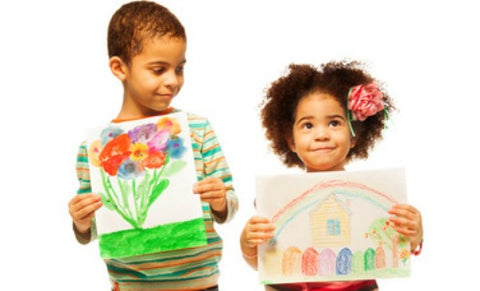- Continue Shopping
- Your Cart is Empty
The Importance of Arts and Crafts

Arts and Crafts: Why Is It Important?
I am sure you can think of a couple of reasons to get your kids doing some arts and crafts. The most obvious is the joy of creating something with their own bare hands. What might surprise you is the long-term impact on this little person’s mental and emotional development. Just maybe, you might be watching the next great modern artist develop. More likely you are simply helping teach your child how to control their hands, solve problems, connect with themselves, figure out mathematics and employ the scientific method. You free them to explore and experiment in a way that teaches them to trust themselves and their individual process. These are lessons that last long after the paint and glue have dried.
Delayed Gratification
Working with different craft materials requires some patience. Sometimes one thing has to dry or cure before another part can be done. Some materials have to be worked with for a while. When that much effort and waiting is put into something it teaches the truth that not everything worthwhile can be obtained instantly. The effort also fosters a sense of value. Kids learn about the time that goes into making something. It can be pointed out that even a plastic toy from a factory has to be “made” and should be valued. Opening up a child to the ideas of appreciation and respect at an early age is essential to forming relationships and awareness.
Confidence
Confidence is very important. It sets the stage for how a child will interact with others and how they present themselves to the world. Ultimately, these factors will affect success as your child’s ability to know their own strengths will change what they expect from themselves and offer to others. When a child knows who they are they are better equipped to handle other personalities and ideas without letting them overtake their own personal philosophy and good sense. This will make a difference when peer pressure arises. A good sense of who they are will help them handle all emotions, bad and good.
Fine Motor Development and Coordination
Learning to coordinate your hands together can be a surprisingly hard skill at first. That’s why tying shoes, using scissors and typing are all a bit challenging at first. Many craft projects introduce using the brain and the body that way in a low-stress environment. Once the hands are used to working together it will be much easier for them to practice their fine motor skills. The dominant hand will naturally start finding ways to make those smaller motions as they are working.
Keep It Fun
Just remember when you are first starting out, don’t put too much pressure on the kids. These benefits create themselves. You don’t need to rush them into accomplishing goals. As they work, they will build on what they already have and create new connections. Working at their skill level will keep them building that confidence in short order. As they get better at things a time to help them challenge their skills will come.








